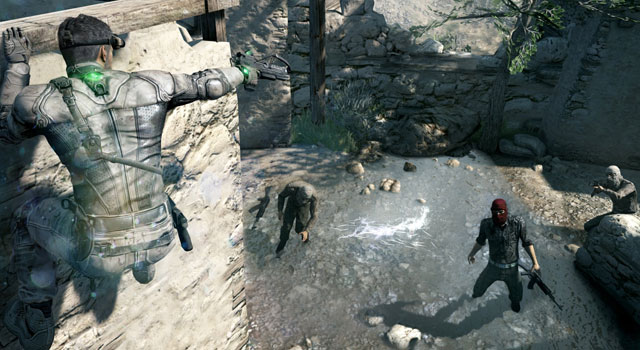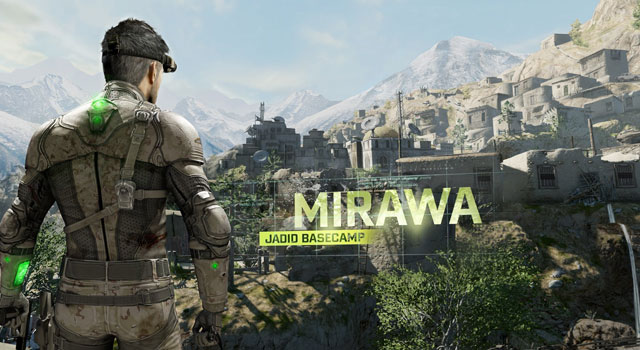Splinter Cell: Blacklist is like Ubisoft’s love letter to all those Splinter Cell fans burned by Splinter Cell: Conviction. It’s a throwback to the good old days where patience as a virtue is rewarded, but at the same time, aggressive actions are not condemned. Blacklist does a mighty fine job of taking all the good bits from past Splinter Cell games and smashing them into one immersive and entertaining package.
Sam Fisher is no longer a rogue agent. He’s now the head of the Fourth Echelon, and must protect American soil against horrifying terrorist attacks. The Paladin, a gigantic plane, is now your base of operations, where you can chose missions, undertake co-operative side quests, upgrade your character and the plane itself to gain benefits in the field. If this all sounds a bit familiar, it’s because it does seem inspired by the likes of Mass Effect 2. This system isn’t bad per se, but the story itself leaves a lot to be desired. While Conviction wasn’t the best Splinter Cell game ever made, I really liked the whole “man on the run” concept. This time around, the plot is painfully clichéd and utterly boring. And yes, the absence of Michael Ironside as Sam Fisher definitely hurts.
The game does incorporate a lot of the good stuff from Conviction, like the fluid cover system, the “Mark and Execute” mechanic, as well as large, sprawling levels.
Speaking of Conviction, it’s a known fact that it was the most un-Splinter Cell game of the entire series, so it’s good to see the return of what could be described as a conventional Splinter Cell game. That being said, the game does incorporate a lot of the good stuff from Conviction like the smooth and fluid cover system, the “Mark and Execute” mechanic as well as large, sprawling levels that offer multiple paths. This marriage of old and new actually works really well for the game, because it doesn’t completely empower the player, but it does give you the tools to become a lethal hunter.
Unfortunately, since the game is dependent on context sensitive actions, things can get a bit messy at times. For example, if you’re hanging on a ledge and are waiting to take an enemy down as he approaches the window, sometimes pressing the default “E” key to initiate a takedown will in fact close the window on the enemy as even interacting with the environment is bound to the same key. Same thing happens if an enemy is standing too close to a door. Oh and there were times when an enemy was standing near a supply crate, and pressing “E” to initiate a takedown made Fisher reach into the supply crate and start restocking ammunition. I was immediately shot in the face.
The game uses an auto-save system, and while that does force players to be a lot more careful, it does come with its own set of issues.
Normally, this wouldn’t be an issue with games that offered a quick save option, but such is not the case in Blacklist. The game uses an auto-save system, and while that does force players to be a lot more careful, it does come with its own set of issues. Sometimes, the save kicks in far too late in a sprawling level, which means if you screw up at the last minute, you’ll have to replay that level up to that point all over again. This becomes worse in co-op, where detection means automatic failure, and since there are no mid-mission checkpoints in some of the co-op levels, you have to replay that level all over again.
Like most stealth games on the market today, Blacklist is all about your play style. You want to be the non-lethal ghost that goes in and out without alerting anyone to his presence? Good on you. Tired of sneaking in the shadows and just want to shoot people in the face? That’s possible too. What works best is the right blend of both where you do execute your enemies with predatory precision and sneak away without being detected.
Money earned can be used to purchase and customise equipment, and for the first time, customise Sam Fisher’s suit.
Depending on your play style, you will be awarded with a certain amount of points at the end of the round. These points are then converted into spendable money that can be used to purchase and customise equipment, and for the first time ever, customise Sam Fisher’s suit to further decrease chance of detection, carry more ammunition, or strengthen your armour for intense fire-fights. I would suggest upgrading your armour as Blacklist has a lot of these ambush-y situations where you’re forced into battle.
Blacklist offers a fairly robust campaign spanning roughly ten missions, and considering each mission may take you anything from half an hour to an hour to complete (depending on how thorough you are), you’re looking at sinking in a healthy amount of time there. And this is just one play through. Every level is scattered with enough variety to warrant at least another play through, maybe with a different play style.
The game becomes a lot more engaging when there are two spies working together to take down a bunch of enemies silently.
The co-op missions are tons of fun as well. These are basically side quests of sorts given to you by your squad that take place during the time line of Blacklist. Most of these can be played solo as well, but trust me, the game becomes a lot more engaging when there are two spies working together to take down a bunch of enemies silently. You probably won’t succeed most of the time, and levels may quickly dissolve into frantic fire fights, but like I said, even the co-op levels have enough variety to warrant a second play through once you’ve learnt the layout.
After you’ve accustomed yourself to the game’s mechanics, take your skills online for some Spies vs Mercenaries action, where as the name suggests, one team plays as fast moving spies, while the other steps into the boots of the well armoured mercenaries. As mercenaries, the action takes place from a first-person perspective, and you’re a lot slower than spies. However, you have more powerful weapons and are tougher to take down. As spies, you must use the shadows to overcome your powerful adversaries, but this time around, you have a split second to take them down head on. No matter which mode you end up playing, most online skirmishes turn into knuckle biting games of cat and mouse, and this is a welcome change of pace from the usual run-and-gun fare.
Remember how good Splinter Cell: Chaos Theory looked on the PC back in the day? Blacklist feels the same on a powerful machine. Crank up the DX 11 effects and you’re treated to an extremely good looking game. At times, however, even with anti-aliasing pumped up, there are tons of noticeable jaggies in the game. Character models just look plain weird, but Sam Fisher looks legit and his animations are as fluid and responsive as ever. If you do manage to play the game on PC, and are an Nvidia user, I would suggest upgrading to the beta drivers released for Blacklist, as this did boost performance significantly.
Splinter Cell: Blacklist isn’t the perfect game, but it’s a fine return to form for a series that seemed to have lost its path. Ubisoft has carefully crafted a fine stealth-action hybrid using all the good bits from previous Splinter Cell games (besides the story, obviously). This results in a game that should please die-hard fans, and yet appeal to newcomers. It definitely has a few issues, but none that should stop you from experiencing and celebrating Sam Fisher’s return.
Test Rig:
- Motherboard: Intel DP67BG Extreme Desktop series
- Processor: Intel Core i7 – 2600K @3.40 GHZ
- Graphic Card: NVIDIA GeForce GTX TITAN
- Ram: Corsair Vengeance 4GB DDR3 @ 1600 MHZ X2
- Power Supply: Cooler Master Silent Pro Gold 1200W

